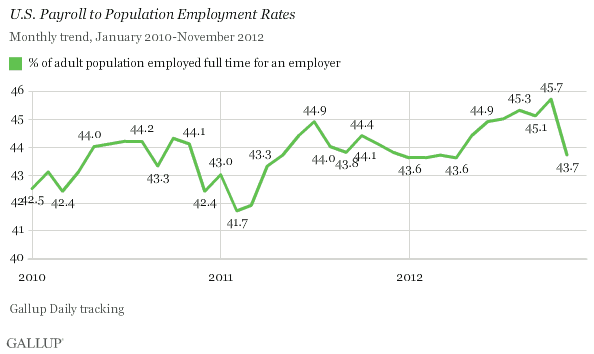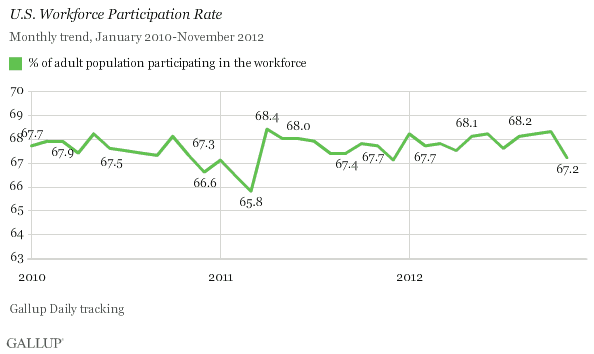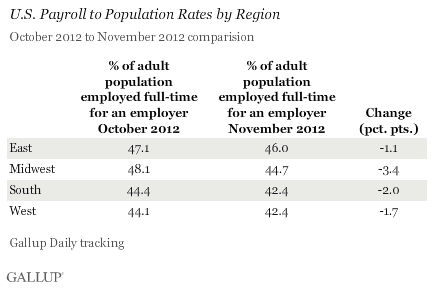WASHINGTON, D.C. -- The U.S. Payroll to Population employment rate (P2P), as measured by Gallup, was 43.7% for the month of November, down from 45.7% in October. This is the largest month-over-month decline in P2P since Gallup began tracking it in January 2010.

Gallup's Payroll to Population metric is an estimate of the percentage of the U.S. adult population aged 18 and older who are employed full time by an employer for at least 30 hours per week. P2P is not seasonally adjusted.
These results are based on Gallup Daily tracking interviews, conducted by landline and cellphone, with more than 29,000 Americans throughout the month. Adults who are self-employed, working part time, unemployed, or out of the workforce are not counted as payroll-employed in the P2P metric.
Because of seasonal fluctuations, year-over-year comparisons are helpful in determining the extent to which the monthly changes are because of seasonal hiring patterns and the extent to which they are the result of changes in the number of permanent full-time positions. Fewer Americans were working full time for an employer in November 2012 than were in November of 2010 and 2011, when P2P rates stood at 44.1%. The November 2012 P2P rate is the first monthly reading this year that is not an improvement over the same month in 2011.
November's P2P decline likely results from workers becoming unemployed or dropping out of the workforce altogether. Gallup's U.S. unemployment rate increased in November to 7.8%, while the number of people active in the workforce -- either working or not working but actively seeking employment -- declined more than a full percentage point to 67.2%. The size of the workforce is also down compared with November 2011, when it was 67.7%.
Traditional unemployment rates are based on the workforce, not the total U.S. adult population, so people dropping out of the workforce can actually mask a declining employment situation. Payroll to Population, on the other hand, is based on the total population, and therefore gives a more accurate representation of the job climate. November's reading demonstrates how a shrinking workforce and rising unemployment can be a double whammy. The two-point P2P decline paints a more negative picture -- but also a more accurate one -- than does the 0.8-point increase in Gallup's U.S. unemployment rate.

Easterners Most Likely to Be Working Full-Time for an Employer
Superstorm Sandy led to an increase in unemployment benefit claims in the East, which in turn has led some experts to suggest that the declining employment situation might be a direct result of the storm. However, according to Gallup's data, P2P declined across all regions, and the East had the smallest October to November decline, while the Midwest saw the biggest decline. Among all regions, the East, at 46.0%, also had the largest percentage of people working full time for an employer in November. At 42.4%, the South and West tied for the lowest P2P rate.

Implications
November's decline in P2P reverses the trend of positive growth seen earlier in the year. While P2P has seasonal ups and downs, the magnitude of the changes last month, combined with year-over-year comparisons that show a deterioration rather than improvement, is troubling. Clearly, November's job climate took a step backward.
The Bureau of Labor Statistics is expected to report an increase in unemployment rates on Friday, which is consistent with Gallup's unemployment data. However, the 0.1- to 0.2-point increase in the BLS figure that experts are predicting will not tell the whole story, which is that the percentage of Americans working full time for an employer in November declined by two points in October. When Americans drop out of the workforce, as happened in November, it masks a decline in jobs. Had those Americans remained in the workforce actively looking for work, Friday's report would show a larger increase in the unemployment rate.
Gallup.com reports results from these indexes in daily, weekly, and monthly averages and in Gallup.com stories. Complete trend data are always available to view and export in the following charts:
Daily: Employment, Economic Confidence, Job Creation, Consumer Spending
Weekly: Employment, Economic Confidence, Job Creation, Consumer Spending
Read more about Gallup's economic measures.
View our economic release schedule.
Survey Methods
Results are based on telephone interviews conducted as part of Gallup Daily tracking from Nov. 1-30, 2012, with a random sample of 29,308 adults, aged 18 and older, living in all 50 U.S. states and the District of Columbia, selected using random-digit-dial sampling.
For results based on the total sample of national adults, one can say with 95% confidence that the maximum margin of sampling error is ±1 percentage point.
Interviews are conducted with respondents on landline telephones and cellular phones, with interviews conducted in Spanish for respondents who are primarily Spanish-speaking. Each sample includes a minimum quota of 400 cellphone respondents and 600 landline respondents per 1,000 national adults, with additional minimum quotas among landline respondents by region. Landline telephone numbers are chosen at random among listed telephone numbers. Cellphone numbers are selected using random-digit-dial methods. Landline respondents are chosen at random within each household on the basis of which member had the most recent birthday.
Samples are weighted by gender, age, race, Hispanic ethnicity, education, region, adults in the household, and phone status (cellphone only/landline only/both, cellphone mostly, and having an unlisted landline number). Demographic weighting targets are based on the March 2011 Current Population Survey figures for the aged 18 and older non-institutionalized population living in U.S. telephone households. All reported margins of sampling error include the computed design effects for weighting and sample design.
In addition to sampling error, question wording and practical difficulties in conducting surveys can introduce error or bias into the findings of public opinion polls.
For more details on Gallup's polling methodology, visit www.gallup.com.
